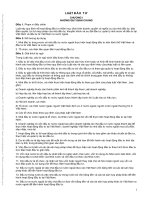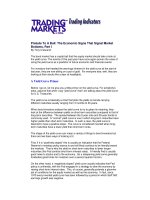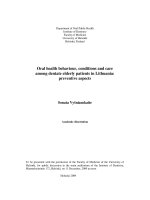Tài liệu Business Ethics: A MANUAL FOR MANAGING A RESPONSIBLE BUSINESS ENTERPRISE IN EMERGING MARKET ECONOMIES pptx
Bạn đang xem bản rút gọn của tài liệu. Xem và tải ngay bản đầy đủ của tài liệu tại đây (2.64 MB, 355 trang )
Business Ethics
U.S. DEPARTMENT OF COMMERCE
International Trade Administration
W ASHINGTON,D.C.
A publication of the
GOOD GOVERNANCE PROGRAM
A MANUAL FOR MANAGING A
RESPONSIBLE BUSINESS ENTERPRISE
IN EMERGING MARKET ECONOMIES
Library of Congress Cataloging-in-Publication statement
Business ethics : a manual for managing a responsible business enterprise
in emerging market economies / U.S. Department of Commerce,
International Trade Administration.
p. cm.
“A publication of the Good Governance Program”
Includes bibliographical references and index.
1. Business ethics. 2. Business ethics—United States. I. United States.
International Trade Administration.
HF5387.B87129 2004
174’.4—dc22
2002056735
ISBN 0-16-051477-0
Certain materials included in this book are reprinted with the kind
permission of their copyright holders. A full list of permissions appears
on page 325.
Published 2004 by the U.S. Department of Commerce,
International Trade Administration.
For sale by the U.S. Government Printing Office, Superintendent
of Documents
Internet:
Telephone: (202) 512-1800
Mail Stop: SSOP, Washington, DC 20402-0001
Stock number: Stock number 003-009-00731-3
Federal Recycling Program
Printed on recycled paper.
This manual is intended to provide general guidance for businesses and practitioners in better understanding
emerging global standards of responsible business conduct. It is distributed with the understanding that the
authors, editors, and publisher are not engaged in rendering legal, accounting, or other professional services.
Where legal or other expert assistance is required, the services of a competent professional should be sought.
The manual contains information on business ethics program design and implementation that was current as
of the date of publication. While every effort has been made to make it as complete and accurate as possible,
readers should be aware that all information that is contained therein is subject to change without notice.
iii
MESSAGE FROM THE
U.S. SECRETARY OF COMMERCE
Business Ethics: A Manual for Managing a Responsible Business Enterprise in Emer-
ging Market Economies
grew out of collaboration between the U.S. Department
of Commerce and many dedicated people and organizations. It is intended to
provide a practical guide to assist owners and managers in meeting emerging
global standards and expectations for an effective business ethics program.
Such a step-by-step guide should have great utility in the emerging market
economies that ring the globe. Many are new players in the modern global econ-
omy and lack experience in what it takes for free markets to function efficiently
and to deliver the jobs, goods, services, consumer choices, and general pros-
perity that are expected from democratic capitalism. Even developed market
economies, moreover, are searching for better ways to meet market challenges.
A fundamental ingredient of any successful market economy is respect for
basic human values: honesty, trust, and fairness. These values must become an in-
tegral part of business culture and practice for markets to remain free and to work
effectively. Private business is at the strategic center of any civil society. It’s where
people go for a job or to invest savings to realize their aspirations for their families.
Having spent most of my life working in American business, I am compelled
to ask, “If businesses fail to honor their responsibilities to society and don’t
believe in corporate stewardship, who in our society will?” Corporate steward-
ship protects the whole “human ecology” of the corporation and its communities,
nurturing the long-term economic growth of both and of their human resources.
You can apply the manual whether you represent business, civil society, or gov-
ernment and whether your enterprise is large or small. I hope you find the
manual easy to use in your development of a business ethics program. We cer-
tainly hope that it will stimulate public debate on the importance of business ethics.
Sincerely,
Donald L. Evans
U.S. Secretary of Commerce
We are particularly grateful to Igor Y. Abramov and Kenneth W. Johnson,
who were the authors of the manual. In addition, we would like to thank the
many businesses and organizations across the globe that have graciously con-
sented to the use of their materials as examples to illustrate the process of
designing a business ethics program. This book would not have been possi-
ble without the efforts of countless practitioners who have labored to devel-
op international standards of responsible business conduct or business ethics
programs for their own enterprises.
Comments and suggestions provided by experts from Armenia, Azerbaijan,
Georgia, Kazakhstan, Romania, Russia, the United States, and Uzbekistan on
early drafts of this book were critical to its development. We are especially
grateful for the insights offered by Gulsum Akhtamberdieva, Anita B. Baker,
Ion Pirvu, Kathleen Purdy, Tatiana Raguzina, Rena Safaralieva, Petr Shikirev,
Andrew Sommers, Robert Strahota, Jon Thiele, John Truslow, Zhan Utkelov,
George Wratney, and several members of the Ethics Officer Association.
We would especially like to thank Matthew Murray for his contributions
to the drafting and editing of this manual. We also thank Danica R. Starks,
who has served as project coordinator of the book, and Elizabeth Ramborger,
John Ward, and William Corley for their contributions to the publication
process.
Valuable editorial assistance was provided by the staff of Publication
Professionals LLC, who edited the text. The cover and text designs were creat-
ed by Maureen Lauran. Composition and production assistance were provided
by the Typography and Design section of the U.S. Government Printing Office.
Finally, we are grateful for F
REEDOM Support Act assistance funds that
were extended to the Good Governance Program by the Coordinator for
U.S. Assistance to the New Independent States. These funds helped make
this book possible.
Susanne S. Lotarski, Ph.D.
Director
Office of Eastern Europe, Russia, and Independent States
International Trade Administration
U.S. Department of Commerce
v
A project of the
GOOD GOVERNANCE PROGRAM
of the
U.S. DEPARTMENT OF COMMERCE
In consultation and cooperation with:
American Chamber of Commerce in Russia
Casals and Associates, Inc.
Center for Business Ethics and Corporate Governance
Chamber of Commerce and Industry of Romania and
Bucharest Municipality
Federal Commission for the Securities Market of the
Russian Federation
Russian Chamber of Commerce and Industry
National Fund for Russian Business Culture
Russian-American Business Dialogue
American Chamber of Commerce
Russian American Business Council
Russian Union of Industrialists and Entrepreneurs
U.S.–Russia Business Council
Transparency International, Azerbaijan
We live in an age of innovation, the growth of free markets, and a world
economy. New technologies, roles for government, and players on the global
scene offer challenging opportunities, demands, and constraints. More peoples
and nations are working together to spread freedom and democratic princi-
ples; to nurture free markets; to protect individual property rights; and to
encourage respect for human rights, the rule of law, and the environment.
With increasing urgency, market and social forces are rewriting the roles
and responsibilities of business as well. Though the profit motive of business
is understood and accepted, people do not accept it as an excuse for ignor-
ing the basic norms, values, and standards of being a good citizen. Modern
businesses are expected to be responsible stewards of community resources
working toward the growth and success of both their companies and their
communities.
Government has an important role in the spread of freedom and demo-
cratic capitalism. It provides for the essential market-oriented legal framework
and reliable dispute resolution processes that allow businesses to compete fair-
ly on the quality, prices, and delivery of their goods and services alone. It
enforces laws, regulations, and judgments to safeguard the social order its citi-
zens value. It cannot, however, act alone. Businesses and civil society must also
be involved in solutions to community problems. They can help in the fight
against the corruption that saps national resources. They must reform the
unethical business practices that breed cynicism and distrust in communities.
Businesses are at the strategic center of a civil society, and they have a
stake in their communities. They depend on free markets and good public
governance for their growth and success, but they are also authors of their
own destiny. Through responsible business conduct, they contribute to the
essential social capital of trust and fairness that makes good governance and
free markets possible.
Markets become free and remain free if their players are responsible and
respect the basic values of honesty, reliability, fairness, and self-discipline.
The alternatives to responsible business conduct are inefficient markets and
costly government regulation. Free flows of capital, talent, knowledge, and
ix
creativity are possible where communities are known for transparency,
respect for property, a market-oriented legal framework, and reliable dispute
resolution mechanisms. The alternatives are a lack of capital, high transac-
tion costs, limited markets, underdevelopment, and poverty.
In short, owners and managers must temper the competitive aspects of
capitalism with concerned citizenship. They must take individual responsi-
bility for the decisions and activities of their enterprises and their impact on
the culture of their enterprise and its stakeholders. A business needs com-
mitted, productive employees, agents, and suppliers to create goods and
services. It needs loyal, satisfied customers and consumers to make a profit.
It needs people who believe in it and in its prospects enough to invest. It
needs to take the long view and to respect the physical environment and the
prospects of future generations.
Over the past few decades, governments, international institutions,
transnational organizations, organized labor, and civil society have been
engaged in an ongoing dialogue into the role of business as responsible
stewards. Standards, procedures, and expectations for business are emerg-
ing worldwide. Enterprises and markets that are unaware of them, or fail
to plan their futures with them in mind, will be unable to participate in the
global dialogue and will risk being left behind as the global market econo-
my expands.
Businesses around the world are designing and implementing business
ethics programs to address the legal, ethical, social responsibility, and envi-
ronmental issues they face. By addressing these issues in a systematic way,
enterprises can improve their own business performance, expand opportuni-
ties for growth, and contribute to the development of social capital in their
markets. They can realize specific business benefits, such as:
•Enhanced reputations and good will
•Reduced risks and costs
•Protection from their own employees and agents
• Stronger competitive positions
• Expanded access to capital, credit, and foreign investment
• Increased profits
• Sustained long-term growth
• International respect for enterprises and emerging markets
Enterprises that excel in these areas create a climate of excellence for
their employees, shareholders, and communities, and contribute to the eco-
nomic wellbeing of their countries.
x Business Ethics
No single volume can tell individual businesses what decisions and activ-
ities will foster and meet the reasonable expectations of their stakeholders.
Each enterprise faces unique political, economic, social, and technological
pressures. Moreover, each has a unique organizational culture that influences
all that its members think, say, and do. However, a guide can demonstrate a
process through which owners and managers can identify enterprise stake-
holders; can foster reasonable stakeholder expectations; and can inspire,
encourage, and support responsible business conduct.
Purpose of this Manual
This manual is intended to aid enterprises in designing and implementing a
business ethics program that meets emerging global standards of responsible
business conduct. Owners and managers can explore the substantial body of
global standards, procedures, and expectations described here. They can
adopt or adapt them on a sector-by-sector and enterprise-by-enterprise basis,
taking into account their particular circumstances, such as applicable laws and
regulations, the size of the enterprise, and the enterprise’s purpose.
This manual explores how a business ethics program helps owners, man-
agers, and their professional advisers build an enterprise to meet these stan-
dards. It builds on three essential concepts to help busy owners and managers
design and implement business ethics programs for their unique enterprises.
1. Responsible business conduct: the choices and actions of employees
and agents that foster and meet the reasonable expectations of enterprise
stakeholders.
2. Responsible business enterprise: an enterprise characterized by good
governance policies and management practices as well as by a culture of
responsible business conduct. It is adept at dealing with the challenges
and complexities of its business environment, but holds closely to its
purpose, core values, and vision.
3. Business ethics program: a tool that owners and managers use to in-
spire, encourage, and support responsible business conduct, by engaging
enterprise stakeholders in order to foster and meet their reasonable ex-
pectations, and designing structures and systems to guide and support
employees and agents.
There is, of course, no one right way to design and implement a business
ethics program, let alone to achieve a culture of responsible business conduct.
Whatever the size or purpose of the enterprise, however, owners and managers
will find value in building an enterprise that sets standards for responsible
business conduct, puts them into practice, and learns from experience. This
Foreword xi
manual distills the experience of business enterprises that have designed and
implemented business ethics programs to address a number of issues:
• What it means to be a responsible business
• How to approach responsible business as a strategy
• What structures and systems help management guide employees and
agents and foster reasonable expectations among enterprise stakeholders
• How to communicate with stakeholders about enterprise standards, ex-
pectations, and performance
• How to align management practices with core beliefs through a business
ethics program
• How to evaluate a business ethics program and learn from it
Four distinct but related disciplines have traditionally guided respon-
sible business conduct: business and professional ethics, organizational
ethics, corporate social responsibility, and corporate governance. The
focus of all four approaches is the governance policies and management
practices that inspire, guide, and support responsible business conduct.
This manual integrates these four disciplines into a single, systemic disci-
pline: the discipline of responsible business conduct.
To help owners and managers apply the discipline of responsible business
conduct, this manual develops a set of tools that will assist them in answering
important questions drawn from each of the four traditional approaches to
responsible business conduct:
1. Business and professional ethics
a. What does a business enterprise owe its customers and consumers?
b. What standards of conduct and performance should an enterprise set
for its employees and agents?
c. What is the role of industry and government in setting business and
professional standards?
2. Organizational ethics
a. What is the optimal mix of values and rules to guide decision-making
and action?
b. What structures, systems, practices, and procedures will best imple-
ment the values and rules of the enterprise?
c. What outcomes should one reasonably expect from an enterprise’s de-
cisions and activities, and how can an enterprise track, measure, and
report them?
xii Business Ethics
3. Corporate social responsibility
a. Who are the legitimate stakeholders of an enterprise, and what can
they reasonably expect?
b. Who speaks for the environment and future generations as stakeholders?
c. What is the role of business in sustainable development?
4. Corporate governance
a. Who can rightfully claim the power to govern an enterprise?
b. How can the board of directors and management best protect the
rights of shareholders, especially minority shareholders?
c. How can the board of directors best guide management to meet the
reasonable expectations of shareholders?
Organization of this Manual
This manual includes 10 chapters, which are arranged in five parts.
The five parts organize the chapters according to the flow of business
ethics program design and implementation, from defining key terms and
addressing global standards and best practices, through evaluating the
business ethics program as a part of organizational learning. Chapters
build on each other, but they may be read alone if the reader is interested
in a particular topic.
Part I, “The Responsible Business Enterprise,” develops a working defi-
nition of the responsible business enterprise (RBE). Chapter 1, “Responsible
Business Conduct in an Emerging Economy,” addresses the challenges busi-
ness enterprises face, especially in emerging market economies. It concludes
that to be part of the solution to the problems facing businesses, enterprises
need to improve their business performance, contribute to the social capital
of their communities, and work with leaders in government and civil society
to develop a market-oriented legal framework and reliable judicial institu-
tions. Chapter 2, “Responsible Management and the Responsible Business
Enterprise,” describes the emerging global standards of performance and
reporting and the benefits of having a business ethics program.
Part II, “The Business Ethics Program,” introduces the reader to the ele-
ments of a business ethics program and its nature as a business strategy.
Chapter 3, “Responsible Business Conduct as Strategy,” treats the key con-
cepts and components of a business ethics program and shows how owners and
managers can approach a business ethics program as a strategy. Chapter 4,
“Creation of a Business Ethics Program,” introduces owners and managers to
the process of developing, reviewing, and approving a business ethics program.
Foreword xiii
Part III, “Structuring the Business Ethics Program,” details the emerg-
ing global standards and best practices of responsible business conduct.
Chapter 5, “Standards, Procedures, and Expectations for the Responsible
Business Enterprise,” discusses responsible board-level governance policies
and management-level vision and value statements, and it describes how to
implement standards, procedures, and expectations. Chapter 6, “Business
Ethics Infrastructure,” discusses the structures and systems that owners and
managers use to implement a business ethics program. Chapter 7, “Business
Ethics Communications and Feedback,” discusses the challenges of commu-
nicating with an enterprise’s stakeholders about standards, procedures, and
expectations, as well as about the enterprise’s performance.
Part IV, “Putting Business Ethics into Practice,” describes how manage-
ment aligns its practices on an enterprise’s core beliefs and follows through
on the expectations created through its business ethics program. Chapter 8,
“Aligning the Responsible Business Enterprise,” examines how an enterprise
needs to have the right employees and agents performing the right tasks in
pursuit of its purpose. It explores how the RBE responds when things go
wrong through the fault of its employees and agents or otherwise. Chapter
9, “Responsible Business Conduct and Practices,” pays particular attention
to the challenges of being a responsible business enterprise in an emerging
market economy, especially dealing with government procurement and con-
tracting, influencing government legislation and regulation, and working
with other business leaders and civil society to develop a market-oriented
legal framework and reliable judicial institutions.
Part V, “Achieving Responsible Business Conduct,” helps owners and
managers determine whether their business ethics program is achieving
measurable goals. Chapter 10, “Program Evaluation and Organizational
Learning,” emphasizes the importance of evaluating a business ethics pro-
gram as an integral part of organizational learning and of what it means to
be an RBE.
How to Use this Manual
The audience for this manual includes decision-makers in enterprises of all
sorts: business, government, academia, and civil society—and their profes-
sional advisers.
Most of the experience in business ethics programs around the globe
involves large, often quite complex, enterprises. Owners, shareholder repre-
sentatives, and managers of such enterprises will find the discussion, work-
sheets, and sample provisions directly applicable. They may also find that it is
in their best interest to encourage or require their suppliers or service
xiv Business Ethics
providers to design and implement a business ethics program to minimize the
risk of supply chain disruption or indirect damage to their reputations.
The bulk of businesses in all economies, especially emerging market
economies, consists of small to medium-sized enterprises (SMEs).
Owners and managers of SMEs face particular challenges, and most chap-
ters discuss specific issues facing SMEs. Some chapters have tables com-
paring the best practices of large, complex enterprises and cost-effective
solutions for the SME.
Individuals, businesses, and nongovernmental organizations seeking to
stimulate a public dialogue on issues and benefits of business ethics will also
find this manual useful. It offers a frame of reference for further dialogue. It
includes definitions of key terms and concepts. It helps define the role of the
private sector in creating transparent markets, strengthening the rule of law,
and supporting good public governance.
Although this manual emphasizes responsible business conduct, associa-
tion members and government officials can also use it as a management tool
to order their affairs. The process described here applies to all enterprises hav-
ing a shared purpose. To be effective, efficient, and responsible, an association
or government agency also should understand its relevant context and organi-
zational culture. It also must establish and communicate to its stakeholders its
core beliefs, standards, procedures, and expectations. In short, an association
or government agency can benefit from designing and implementing an ethics
and compliance program similar to the business ethics program described here.
Finally, members of the press and other media can use this manual as a
framework to develop a series of articles or programs as features to raise
their audiences’ awareness of emerging global standards and best practices.
As business news events occur, the media can use this understanding to
develop and report business events as news items—confident that their read-
ers will appreciate the significance of their reporting. They can then devel-
op an editorial position and can publish a body of opinion-editorial pieces to
stimulate national and community dialogue.
When a business enterprise is ready to design and implement its busi-
ness ethics program, the RBE Worksheets and appendices will aid it in col-
lecting and analyzing the data necessary to build an effective program. The
worksheets can be used as checklists to ensure that owners, managers, and
working groups taking on this task have considered all relevant circum-
stances for their enterprise. These circumstances may include fundamental
matters such as the political, economic, and social context and organization-
al culture of the enterprise. An enterprise will be most effective at building a
business program if working groups of representative stakeholders are guid-
ed by an objective facilitator, whose sole responsibility is to help the group
stay on task and consider all relevant points of view.
Foreword xv
What sets this manual apart from general management texts and busi-
ness ethics books is an emphasis on building formal enterprise structures,
systems, and practices to achieve responsible business conduct and to embed
it in the organizational culture. This manual emphasizes the process by
which owners and managers design and implement a business ethics pro-
gram, recognizing that each enterprise faces unique circumstances. As such,
it does not answer specific legal or ethics questions.
What it does provide is a comprehensive framework for addressing
ethics, compliance, and social responsibility questions on a strategic basis. It
helps owners and managers organize the body of practical wisdom reflected
in legal requirements, proposed guidelines, best practices, case studies, and
even traditions. It can stimulate and legitimize stakeholder dialogue into
matters of significance to all.
The challenges facing business are many, but its importance as the sec-
tor of society that generates consumer goods, jobs, wealth, economic
progress, and, yes, even tax revenues cannot be underestimated. By working
through this manual, business leaders, owners, and managers will construct
their own framework for approaching a challenging, complex world more
creatively and confidently.
Grant D. Aldonas
Under Secretary for International Trade
U.S. Department of Commerce
Igor Y. Abramov
Director, Good Governance Program
International Trade Administration
U.S. Department of Commerce
Kenneth W. Johnson
Director
Ethics and Policy Integration Centre
Washington, D.C.
xvi Business Ethics
xvii
CONTENTS
Message from the U.S. Secretary of Commerce iii
Acknowledgements V
Foreword ix
Abbreviations and Acronyms xxi
I The Responsible Business Enterprise
Responsible Business Conduct in an
Emerging Market Economy 3
Evolution to a Market Economy
Tr ansition to a Market Economy
The Individual Business in an Emerging Market Economy
SUMMARY 20
RESPONSIBLE BUSINESS ENTERPRISE CHECKLIST 20
Responsible Management and the
Responsible Business Enterprise 21
Improving Business Performance
Generating Social Capital
Working with Leaders in Business, Government, and
Civil Society
Building on the Foundation of Responsible
Business Conduct
Adopting Global Standards and Best Practices
SUMMARY 39
RESPONSIBLE BUSINESS ENTERPRISE CHECKLIST 40
II The Business Ethics Program
Responsible Business Conduct as Strategy 43
Planning, Strategy, and the Business Ethics Program
2
3
1
xviii Business Ethics
Establishing the Nature of the Program
Building a Responsible Business Enterprise
Knowing the Structural Components of the Program
Planning the Business Ethics Program
Engaging the Enterprise’s Stakeholders
Adopting a Design, Review, and Approval Process
SUMMARY 63
RESPONSIBLE BUSINESS ENTERPRISE CHECKLIST 64
Creation of a Business Ethics Program 65
Planning an Effective Business Ethics Program
Understanding the Program Logic Model
Scanning the Relevant Context
Scanning the Enterprise’s Internals
SUMMARY 77
RESPONSIBLE BUSINESS ENTERPRISE CHECKLIST 77
III Structuring the Business Ethics Program
Standards, Procedures, and Expectations for the
Responsible Business Enterprise 93
Standards and Procedures
Responsible Governance
Principles for Setting Management Standards, Procedures,
and Expectations
Management Vision for the Enterprise
Management Standards, Procedures, and Expectations
Typical Code of Conduct Provisions
SUMMARY 124
RESPONSIBLE BUSINESS ENTERPRISE CHECKLIST 124
Business Ethics Infrastructure 129
Designing Business Ethics Infrastructure
Determining Systems of Authority, Responsibility,
and Accountability
SUMMARY 144
RESPONSIBLE BUSINESS ENTERPRISE CHECKLIST 145
5
4
6
Contents xix
Business Ethics Communications
and Feedback 147
Communicating and Providing Feedback
Communicating Standards and Fostering Reasonable
Expectations
Ensuring Members Follow Standards and Meet Expectations
SUMMARY 176
RESPONSIBLE BUSINESS ENTERPRISE CHECKLIST 177
IV Putting Business Ethics into Practice
Aligning the Responsible Business Enterprise 185
Understanding the Importance of Alignment
Getting the Right People in the Right Places
Encouraging Employees to Follow Standards and Procedures
Dealing with Mistakes, Misconduct, or Misunderstandings
SUMMARY 204
RESPONSIBLE BUSINESS ENTERPRISE CHECKLIST 205
Responsible Business Conduct and Practices 207
Challenges to the Responsible Business Enterprise
Relationships with Government Officials and Entities
Role of the Private Sector in the Regulatory Process
Government Contracting and Procurement
Role of Voluntary Action
Relationships with Foreign Businesses and Governments
SUMMARY 223
RESPONSIBLE BUSINESS ENTERPRISE CHECKLIST 224
V Achieving Responsible Business Conduct
Program Evaluation and Organizational
Learning 229
Ensuring Organizational Learning
Importance of Program Evaluation
Developing a Data Collection Plan
Reporting Program Performance
Conclusion—and New Beginning
RESPONSIBLE BUSINESS ENTERPRISE CHECKLIST 242
8
7
9
10
xx Business Ethics
Appendices 247
A Sample Ethical Decision-Making Model 249
B Basic Guidelines for Codes of Business Conduct 253
C Sample Integrity Pact 259
D Sample Declaration of Integrity in Business Conduct 265
E Sample Supply Chain Management Questionnaire 267
F Basic Information on the U.S. Foreign Corrupt Practices Act 270
G Fighting Corruption and Safeguarding Integrity 278
H Extracts from the U.S. Federal Sentencing Guidelines
for Organizations 285
I Extracts from the Australian Criminal Code 290
NOTES 293
GLOSSARY 310
RESOURCES AND FURTHER READING 318
PERMISSIONS 325
INDEX 326
ABOUT THE AUTHORS 333
List of RBE Worksheets
1 Business Ethics Program Logic Model 78
2 Relevant Context Data Collection 80
3 Stakeholder Pressure Data Collection 82
4 Organizational Culture Questionnaire 84
5 Questions for the Responsible Business Enterprise 86
6 Sample Outline for a Code of Conduct 125
7 RBE Standards and Expectations Worksheet 127
8 Business Ethics Infrastructure Worksheet 146
9 Communications Needs Assessment Worksheet 178
10 Tr aining Program Outcomes Worksheet 179
11 Communications Infrastructure Worksheet 181
12 Enterprise Alignment Worksheet 206
13 Responsible Business Practices Worksheet 225
14 Organizational Culture Worksheet 243
15 Process Evaluation 244
16 Outcomes Evaluation 245
ABBREVIATIONS AND ACRONYMS
ACFE Association of Certified Fraud Examiners
AML anti–money laundering
CEO chief executive officer
CERES Coalition for Environmentally Responsible Economies
CSR corporate social responsibility
FCPA Foreign Corrupt Practices Act
FSGO Federal Sentencing Guidelines for Organizations
GPA Agreement on Government Procurement
GRI Global Reporting Initiative
ICC International Chamber of Commerce
IEEE Institute of Electrical and Electronic Engineers
ILO International Labor Organization
ISO International Standards Organization
LCE large, complex enterprise
NGO nongovernmental organization
NTT Nippon Telegraph & Telephone
NYSE New York Stock Exchange
OECD Organization for Economic Cooperation and Development
RBE responsible business enterprise
RICO Racketeer Influenced and Corrupt Organizations Act
SABA Strategic Alliance of Business Associations
SAI Social Accountability International
SEC U.S. Securities and Exchange Commission
SME small to medium-sized enterprise
WTO World Trade Organization
xxi
The Business
Ethics Program
I
The Responsible
Business
Enterprise
This chapter explains what it means to be a responsi-
ble business enterprise (RBE) in an emerging market
economy. It describes the role of responsible business
conduct as owners and managers strive to improve
business performance, make profits, and contribute to
economic progress in their communities.
It lays a foundation for the chapters that follow
by examining the legacies of a command economy
and the challenges those legacies present to busi-
nesses. The chapter concludes that a responsible
business can contribute to a successful evolution to
a market economy by improving its business per-
formance; by helping build social capital in its
economy; and by working with leaders in business,
government, and civil society to develop essential
market-oriented institutions.
Evolution to a Market Economy
Where a society wants to evolve from a command to
a market economy, the challenges presented to indi-
vidual enterprises can be daunting. All economies
face the same fundamental issues of responsible busi-
ness conduct—product quality, transparency in
financial matters, workplace health and safety, pro-
tection of the environment, protection of workers,
and compliance with laws and industry standards.
However, they are magnified in both degree and kind
when an entire society is making a rapid evolution
toward a market economy.
Responsible Business
Conduct in an Emerging
Market Economy
1
•Evolution to a
Market Economy
• Transition to
a Market
Economy
• The Individual
Business in an
Emerging
Market Economy









